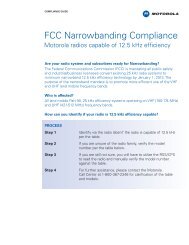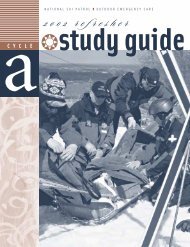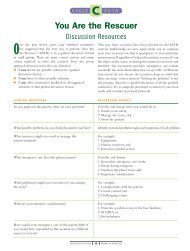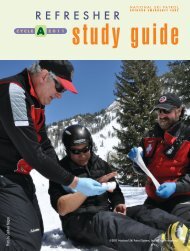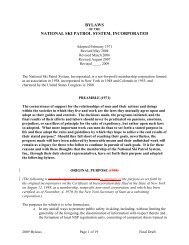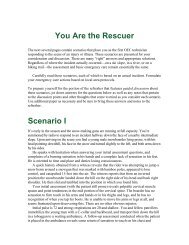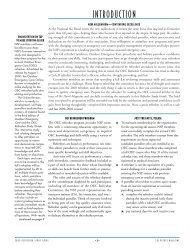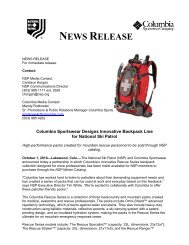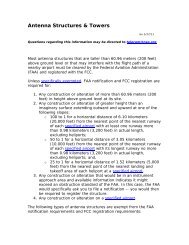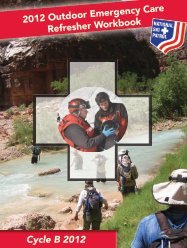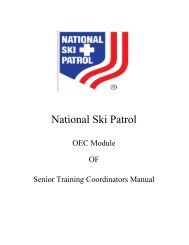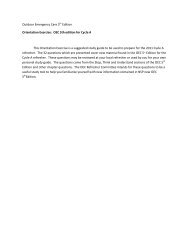Sierra Samaritans - National Ski Patrol
Sierra Samaritans - National Ski Patrol
Sierra Samaritans - National Ski Patrol
You also want an ePaper? Increase the reach of your titles
YUMPU automatically turns print PDFs into web optimized ePapers that Google loves.
d a clear difference indicating that bracing increased knee stability.<br />
may also protect the native ACL?<br />
Unfortunately, that question has not been<br />
directly studied among skiers as it has<br />
been among college football players.<br />
While there really isn’t enough data to say<br />
for sure, my own experience would suggest<br />
that it’s likely.<br />
So we are left with many more questions<br />
than answers. What we do know is<br />
that 1) ACL tears are extremely common<br />
among many professional athletes and<br />
weekend warriors, especially skiers; 2)<br />
ACL reconstruction is a highly effective<br />
but painful intervention with a 16-week<br />
or longer rehabilitation period; 3) temporary<br />
ACL bracing is generally recommended<br />
after surgery to protect the graft<br />
during its most vulnerable phase; 4)<br />
reconstructed ACLs can be re-ruptured;<br />
and 5) there is solid experimental evidence<br />
that bracing reduces strain on the<br />
ACL graft during the healing process.<br />
What we don’t know for sure is<br />
whether bracing will reduce the risk of rerupturing<br />
the ACL or even prevent ACL<br />
tears in the first place or well after rehab.<br />
One brace manufacturer, DonJoy, is so<br />
confident that its top-of-the-line brace<br />
can prevent re-rupture of the ACL that<br />
the company says it will actually pay a<br />
portion of the bill if you re-rupture the<br />
ACL graft while wearing the brace.<br />
Clearly we need more data to answer<br />
this central question. In the interim, as I<br />
continue to recover from what my wife<br />
insists had better be my last ACL reconstruction,<br />
I’m left to ponder the fate of my<br />
brace. Certainly, being able to pass the<br />
PSIA Level III exam without an ACL and<br />
while braced has endeared the device to<br />
me. I feel a subjective sense of support<br />
and security when I wear it, and studies<br />
would indicate that I also experience an<br />
objective increase in support. What little I<br />
lose in range of motion because of the<br />
brace I more than make up for knowing<br />
that the strain on the knee is relieved<br />
while wearing it. Without the brace, I<br />
would not have been able to ski at all.<br />
For Eric Schlopy, even the slight<br />
weight, drag, and movement restriction<br />
of a brace can mean the difference<br />
between winning and losing. But I’m not<br />
Eric Schlopy. I want to ski and ski well,<br />
but I hardly notice drawbacks from the<br />
brace. What I do notice is my increased<br />
sense of stability and confidence. I might<br />
be weak-kneed, but I’m no wimp, and I’m<br />
not ready to succumb just yet. ✚<br />
References<br />
Boughton, B. “Prophylactic: Football Linemen<br />
Experience the Greatest Benefit.” The<br />
Magazine of Body Movement and Medicine<br />
June 2000: 21–25.<br />
Nemeth, G. et al. “Electromyographic Activity in<br />
Expert Downhill <strong>Ski</strong>ers Using Functional<br />
Knee Braces After Anterior Cruciate Ligament<br />
Injuries.” The American Journal of Sports<br />
Medicine 25, no. 5 (1997): 635–641.<br />
Beynnon, B.D. et al. “The Effect of Functional Knee<br />
Bracing on the Anterior Cruciate Ligament in<br />
the Weightbearing and Non-weightbearing<br />
Knee.” The American Journal of Sports<br />
Medicine 25, no. 3 (1997): 353–359.<br />
Beynnon, B.D. et al. “An In-vivo Investigation of<br />
Anterior Cruciate Ligament Strain: The Effect<br />
of Functional Knee Bracing and Attachment<br />
Strap Tension.” Paper presented at the annual<br />
meeting of the Orthopedic Research Society,<br />
Orlando, FL.<br />
Blickenstaff, K.R. et al. “Analysis of a Semitendinosus<br />
Autograph in a Rabbit Model.”<br />
American Journal of Sports Medicine 25, no. 4<br />
(1997): 554–559.<br />
Dr. Michael Patmas is the medical director of<br />
the Providence Ambulatory Care and Education<br />
Center in Portland, Oregon. He is a PSIA-certified<br />
Level III alpine ski instructor at Mount Hood<br />
Meadows, Oregon.<br />
W inte r 2005 | <strong>Ski</strong> <strong>Patrol</strong> Magazine 21



